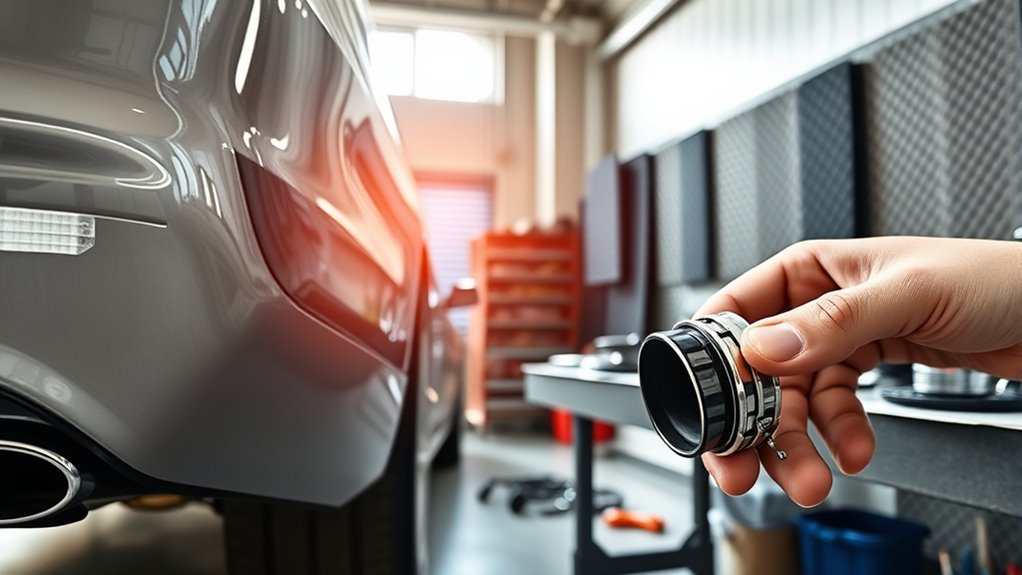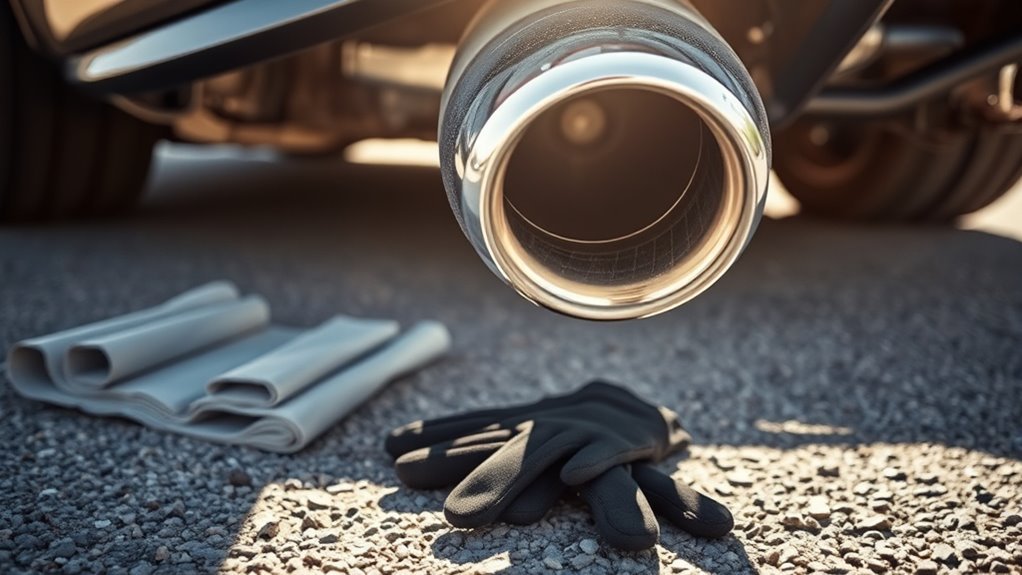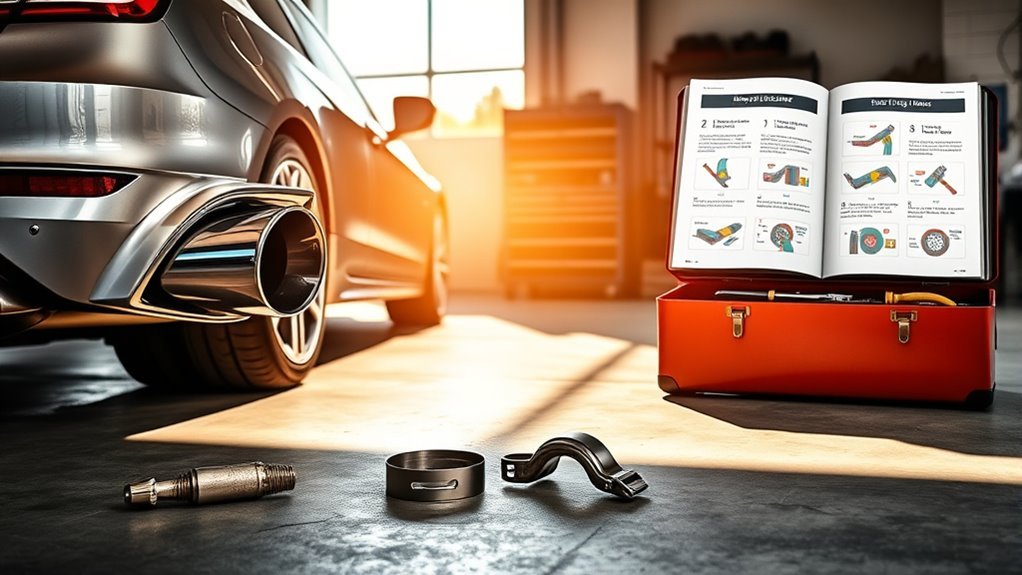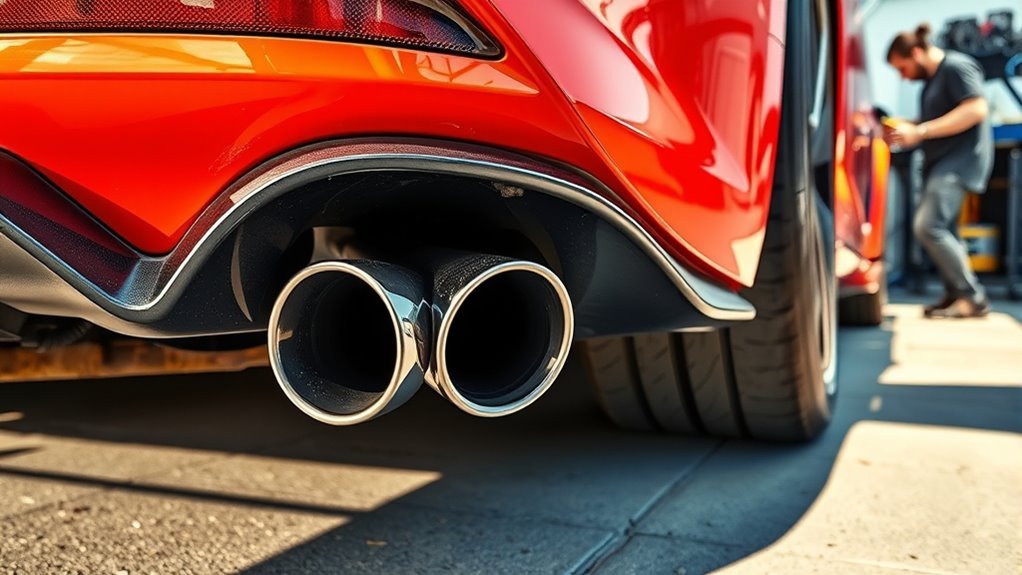To reduce exhaust drone, start by inspecting your exhaust system for leaks or damage, then upgrade to a high-quality muffler designed to target resonant frequencies. Consider installing resonators to cancel drone pulses and adjust pipe lengths or diameters to shift sound waves away from problematic frequencies. Also, maintain steady engine RPMs and smooth throttle input to minimize vibrations. Finally, evaluate exhaust layout or consult a professional for tailored solutions. Exploring these methods reveals a thorough approach to mastering exhaust sound control.
Understanding What Causes Exhaust Drone

Although exhaust drone might seem like a simple annoyance, it actually results from specific acoustic and mechanical factors within your vehicle’s exhaust system. You’re dealing with exhaust frequency, the resonant tone generated when sound waves reflect and amplify inside the exhaust pipes. These sound waves, created by combustion pulses, interact with the geometry and materials of the system. When the exhaust frequency aligns with the natural resonant frequencies of components, it causes persistent, low-frequency vibrations you perceive as drone. This phenomenon limits your freedom on the road by creating an intrusive noise during steady throttle conditions, especially at highway speeds. Understanding this interplay between sound waves and exhaust frequency empowers you to seek targeted solutions that minimize drone without sacrificing performance or the exhilarating freedom your vehicle offers.
Inspecting Your Exhaust System for Issues

You’ll want to start by checking your exhaust system for leaks, as even small gaps can amplify drone. Next, examine the muffler’s condition closely, since corrosion or damage can alter sound frequencies. Identifying these issues early helps target the root cause of the noise.
Check for Leaks
When inspecting your exhaust system for issues, start by checking for leaks that can amplify exhaust drone. Exhaust leaks disrupt the intended flow and pressure, causing abnormal vibration and increased noise levels. To locate leaks, listen for hissing or popping sounds while the engine runs, especially near joints, welds, and clamps. You can also feel for escaping gases with your hand—be cautious of hot surfaces. Identifying and sealing these leaks restores proper sound absorption by the muffler and resonator, reducing drone considerably. Ignoring leaks undermines the system’s acoustic design, compromising your freedom from intrusive noise. Effectively addressing exhaust leaks guarantees your vehicle maintains ideal sound control and performance integrity, allowing you to enjoy a quieter, more comfortable ride.
Examine Muffler Condition
After addressing potential leaks, the next step is to examine the muffler’s condition, as it plays a key role in controlling exhaust drone. Start by visually inspecting for rust, cracks, or holes, which can degrade muffler performance and increase unwanted noise. Pay close attention to internal components by tapping lightly and listening for irregular rattles indicating loose parts. Evaluate muffler maintenance history—neglected units often lose efficiency, negatively impacting exhaust performance. If wear or damage is evident, consider repair or replacement to restore ideal sound attenuation. Remember, a well-maintained muffler not only minimizes drone but also guarantees your exhaust system operates freely and efficiently, preserving the driving experience you value. Prioritize this analytical approach to confidently reduce exhaust drone and maintain system integrity.
Upgrading to a High-Quality Muffler

Although exhaust drone can stem from various factors, upgrading to a high-quality muffler directly addresses the acoustic resonance responsible for the low-frequency noise. When you select a muffler, focus on advanced muffler materials that optimize sound attenuation and durability. Materials like stainless steel not only resist corrosion but also influence the muffler’s ability to absorb or reflect specific sound frequencies. By targeting the problematic low-frequency range, a well-engineered muffler disrupts resonance patterns that cause drone. Precision in muffler design—such as chamber volume, baffle placement, and packing density—further refines sound frequency control, reducing unwanted vibration. Upgrading your muffler empowers you to regain auditory freedom on the road, minimizing fatigue and enhancing your driving experience without compromising exhaust flow or performance.
Installing Resonators to Cancel Out Drone
Upgrading to a high-quality muffler markedly reduces exhaust drone by targeting acoustic resonance, but further refinement often requires additional components like resonators. You’ll need to choose from resonator types—chambered, straight-through, or Helmholtz—each designed to cancel specific frequency ranges contributing to drone. Installation techniques depend on your vehicle’s exhaust layout; typically, you insert the resonator upstream or downstream of the muffler. Precision cutting and welding guarantee airtight seals, critical for resonator effectiveness. You must also consider resonator placement to avoid disrupting exhaust flow and maintain performance. By carefully selecting the resonator type and applying proper installation techniques, you can considerably neutralize unwanted drone frequencies, optimizing your exhaust’s sound profile and reclaiming your ride’s freedom from irritating resonance.
Using Sound-Deadening Materials in the Cabin
A critical step in minimizing exhaust drone involves applying sound-deadening materials inside the cabin. By enhancing sound insulation with specialized cabin materials, you create a barrier that reduces noise transmission from the exhaust system. Focus on high-density foam, mass-loaded vinyl, and butyl-based mats, as these effectively absorb and block low-frequency drone. Apply these materials strategically on doors, floor panels, and the firewall to target primary sound pathways. This method doesn’t alter vehicle mechanics, preserving your freedom to customize exhaust tone while controlling in-cabin noise. Proper installation requires thorough surface preparation and layering for maximum isolation. Ultimately, using sound-deadening cabin materials offers a precise, measurable reduction in drone, letting you enjoy quieter rides without sacrificing the raw driving experience you value.
Adjusting Engine RPM and Driving Habits
To minimize exhaust drone, you’ll want to keep your engine within its ideal RPM range where resonance frequencies are reduced. Avoid rapid throttle changes by applying smooth acceleration techniques that prevent sudden spikes in engine noise. Adjusting your driving habits this way can greatly decrease the perception of drone inside the cabin.
Optimal RPM Range
Although exhaust drone can vary with many factors, maintaining your engine within its optimal RPM range considerably reduces the resonance that causes this unwanted noise. Staying within the ideal RPM benefits both engine efficiency and sound control, minimizing the frequency overlap that leads to drone. By consistently operating in the RPM band designed for your engine’s peak torque, you avoid excessive vibration amplification. This precise adjustment fosters optimal driving conditions, balancing power output and acoustic comfort. You’ll find that monitoring your tachometer and shifting gears proactively helps you sustain this RPM zone, ultimately granting you greater control over exhaust sound levels. Mastering this technical aspect is essential for anyone seeking freedom from annoying drone without compromising performance or driving enjoyment.
Smooth Acceleration Techniques
When you adjust your acceleration to be smoother, you directly influence engine RPM fluctuations that contribute to exhaust drone. Implementing smooth acceleration techniques means modulating throttle response carefully to avoid abrupt changes in engine speed. By applying gradual pressure on the accelerator pedal, you minimize rapid RPM spikes that amplify drone frequencies. This controlled throttle input stabilizes the combustion cycle, reducing resonance within the exhaust system. Adopting these driving habits enhances your vehicle’s acoustic comfort without sacrificing performance freedom. Focus on anticipating traffic flow and shifting gears at ideal RPMs, which further smooths engine load shifts. Ultimately, refining your throttle response through deliberate, smooth acceleration grants you control over engine vibrations, greatly diminishing exhaust drone while preserving the driving experience you value.
Considering Exhaust System Layout Changes
Since exhaust drone often results from specific resonant frequencies within the exhaust path, altering the system’s layout can effectively disrupt these frequencies. You should evaluate the exhaust routing to identify sections where sound waves reinforce each other, causing drone. Changing pipe lengths, diameters, or bends can shift the dominant sound frequency, minimizing resonance. For example, increasing the distance between components or adjusting bends can break up standing waves responsible for drone. Additionally, relocating or redesigning resonators and mufflers within the system alters how sound frequencies interact, further reducing drone. By strategically modifying your exhaust layout, you gain control over the acoustic properties without sacrificing performance. This analytical approach lets you tailor your exhaust system’s sound profile, achieving a balance between freedom and comfort.
Consulting a Professional for Custom Solutions
If you’re aiming for an exhaust system that effectively eliminates drone without compromising performance, consulting a professional can provide tailored solutions based on your vehicle’s unique characteristics. Through professional consultation, you gain access to expertise in diagnosing drone frequencies and understanding how factors like pipe diameter, muffler design, and resonance chambers interact. A specialist can craft custom exhaust solutions that precisely target problematic frequencies, balancing sound attenuation with ideal flow dynamics. This analytical approach guarantees you maintain engine efficiency while reducing unwanted noise. By leveraging diagnostic tools and performance data, professionals customize modifications specific to your setup, granting you the freedom to enjoy a quieter ride without sacrificing power or throttle response. Trusting expert guidance streamlines the process, delivering precise, measurable improvements in exhaust drone reduction.

